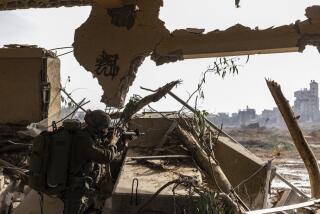Pakistan Connection Seen in Taliban’s New Tactics
Telephone and power lines haven’t reached the villages clinging to the craggy mountainsides of Kunar province. Digital phones and computer chips are even further beyond the shepherds’ imaginations.
So when sophisticated bombs detonated by long-range cordless phones began blowing up under U.S. and Afghan military vehicles on mountain tracks, investigators knew they had to search elsewhere for the masterminds.
Afghan officials immediately focused on nearby Pakistan and its military, whose Inter-Services Intelligence agency helped create the Taliban in the early 1990s and provided training and equipment to help the Muslim extremists win control over most of the country.
Pakistani President Pervez Musharraf joined the Bush administration’s war on terrorism and publicly turned against the Taliban immediately after the Sept. 11 attacks. But Afghan officials allege that Taliban and allied fighters who fled to Pakistan after the U.S.-led invasion of Afghanistan in late 2001 are learning new, more lethal tactics from the Pakistani military at numerous training bases.
“Pakistan is lying,” said Lt. Sayed Anwar, acting head of Afghanistan’s counter-terrorism department. “We have very correct reports from their areas. We have our intelligence agents inside Pakistan’s border as well.
“If Pakistan tells the truth, the problems will stop in Afghanistan. They say they are friends of Americans, and yet they order these people to kill Americans.”
At least 38 U.S. troops have died from hostile fire in Afghanistan this year, higher than the annual combat death toll for any year since the invasion.
Musharraf has denied that his military supports the Taliban or any other Afghan insurgents and the Bush administration and U.S. military spokesmen continue to praise Pakistan’s role in combating terrorism.
Pakistan’s army recently added 4,000 troops to the 70,000 soldiers patrolling the rugged, nearly 1,500-mile, border between the countries in what it says is a determined effort to stop infiltrations of Afghanistan.
Pakistani Maj. Gen. Shaukat Sultan, a military spokesman, said it was ridiculous to suggest that Pakistan had a secret operation to train insurgents to build complex electronic bombs.
“This is just a figment of some absurd mind, nothing else,” Sultan said.
High-tech bombs similar to those being found in Afghanistan have killed Pakistani soldiers too, he said. More than 250 Pakistani troops have died in border operations in the last year, Sultan said.
“We haven’t found any sanctuary, so far, where such items probably could be made,” he said, adding that Pakistan’s military didn’t know where the sophisticated bomb-making technology was coming from.
Anwar, the Afghan official, who has worked in intelligence for 27 years, acknowledged that there was no smoking gun linking insurgents in Afghanistan to Pakistan’s military intelligence.
Yet despite the Pakistani military’s assertions, increasing numbers of guerrillas are crossing into eastern and southern Afghanistan, Anwar and other Afghan officials said.
“Last year, the enemy wasn’t able to attack our checkpoints or plant so many mines,” Anwar said. “This year, they have become very strong.”
Anwar said reports from intelligence agents across the border and 50 captured prisoners describe an extensive network of militant training camps in areas of Pakistan’s federally administered North Waziristan tribal area where government forces are firmly in control.
Tauda China, a village in the area, which is home to Pushtun tribes, is the site of one camp where Inter-Services Intelligence agents trained militants, Anwar said. He alleged that there were as many as six other camps in the surrounding valley, which is closed to outsiders and guarded by Pakistani troops and armed Afghans.
“Our agents have been there,” Anwar said. “They tried to enter the valley and the soldiers didn’t allow them.”
Zulfiqar Ali, a Pakistani journalist who freelances for the Los Angeles Times, recently reported that at least some training camps that were closed on Musharraf’s orders have been reopened.
The government denies that there are training camps. But Ali, who also writes for the Pakistani magazine the Herald, visited one camp and found armed militants with fresh recruits as young as 13 undergoing 18-day “ideological orientation” and weapons training. Several sources said 13 militant camps had been reactivated in the Mansehra region alone in the first week of May.
Militants said their official funding had continued during Musharraf’s ban, but the camps had been abandoned and falling apart until this spring.
“Our transport fleet is back, electricity has been restored and the communications system is in place,” a militant guide reportedly boasted to Ali.
The reported reopening of militant training camps in Pakistan coincides with the discovery of the high-tech bombs in Afghanistan.
Two months ago, Afghan security forces discovered six high-tech bombs in the town of Sarowbi, east of Kabul, the Afghan capital. The triggers consisted of long-range cordless phones attached with black electrical tape to electronic boxes, which Anwar believes convert the ringing phone’s signal into an electrical charge, detonating the explosives.
“These phones are Pakistani-made phones,” he said.
Since March, when heavy winter snow in the insurgents’ hide-outs began to melt, the Taliban and its allies have been intensifying attacks on military and civilian targets in Afghanistan.
In addition to the rising number of U.S. deaths, about 700 people, including Afghan civilians, soldiers and insurgents, have died in the escalated fighting.
In late June, suspected Taliban guerrillas ambushed a four-man Navy SEAL reconnaissance unit high in the Hindu Kush mountain range of Kunar province. Only one of the SEALs survived the attack, and only by good fortune, according to the Pentagon’s account. A rocket-propelled grenade blast knocked him down a mountainside, and despite his wounds he managed to escape to a village that gave him shelter.
Sixteen U.S. troops sent to rescue the SEALs died when insurgents shot down their helicopter with a rocket-propelled grenade.
Lt. Naqibullah Nooristani, operations commander for Afghan troops fighting alongside U.S. forces in Kunar, said the Taliban and its allies were proving so resilient because they were receiving improved training and equipment just across the border in Pakistan.
The guerrillas who escaped after attacking the U.S. troops left behind trash that suggests they have a good supply chain, Nooristani said.
“When our soldiers got up on the mountain, we saw empty cans of Pepsi and old running shoes, which means they changed into new ones for the operation,” the lieutenant said, sitting on the edge of a cot where he sleeps next to his desk.
“They have Pepsis in the mountains while I can’t find them here in the city,” Nooristani said. “That means they are well supported.”
The lieutenant estimated there were 300 Taliban fighters just in the Pec valley northwest of Asadabad, the provincial capital. Thousands more are fighting in several other border provinces in eastern and southern Afghanistan, Afghan officials said.
Police recently found four remote-controlled bombs in the luggage of an Afghan taxi passenger traveling on the main road from Jalalabad, near the Pakistani border, said Anwar, the Afghan counter-terrorism chief. The detonators were small, silver-colored explosive capsules that were made in Pakistan, he said.
The man transporting the bomb components, Sanaullah Khan, was from Parwan province, north of Kabul.
Under interrogation, Khan said he had entered Afghanistan with four Pakistani men after receiving training at a camp in Shamshatu, near Peshawar, Pakistan, Anwar said, reading from an interrogator’s report.
Khan provided few details about the training camp, Anwar said.
Shamshatu is the site of a large U.N. camp for Afghan refugees. As recently as this spring, Pakistani newspaper reports said 90% of the camp’s residents were loyal to Gulbuddin Hekmatyar, a former prime minister and warlord whose Hizb-i-Islami militia is now allied with the Taliban against the U.S.-led coalition in Afghanistan.
Khan told investigators he had received the explosive devices found in his bag from a Pakistani whom he identified as Fazal Rabi. He said Rabi lived at the camp and was “very well connected with Al Qaeda,” according to the interrogation report.
Lt. Gen. Moin Faqir, who oversees the Afghan army’s operations as central corps commander, said his forces first started seeing bombs with computer components six months ago in Kunar province.
“It is not easy to use these mines unless you are well trained for it,” he said.
Unlike conventional land mines that have plagued Afghanistan for decades, these new devices are not triggered by the pressure of wheels rolling over them, Faqir said.
Instead, they are designed to explode directly under the vehicle’s passenger cab, increasing the chances that a relatively small explosion would maim or kill. They are also easier to conceal than regular land mines.
Faqir said he could not say with certainty who was providing the equipment and training to build the new bombs.
“I think we all know where these mines are from,” he added with a pained smile.
The Afghan general chose his words carefully. A uniformed U.S. military advisor was sitting on a couch next to him, taking notes on everything he said. Without using names, Faqir made it clear he thought the source of the sophisticated bombs was an enemy of the worst kind because it pretended to be an ally.
“No one should have two faces with his friend,” he said, adding that such people would suffer shame and destruction. “Once you shake hands with somebody, you should stand with him till the end.”
More to Read
Start your day right
Sign up for Essential California for news, features and recommendations from the L.A. Times and beyond in your inbox six days a week.
You may occasionally receive promotional content from the Los Angeles Times.






